Woodworking as Functional Art
by Stephen Winer
Click on any picture to see a larger version.
The table above is my first go at turning art into functional art. I have been successful with my "Pieces" sculptural series and wanted to express it in furniture so this is the first in a series. I use a variety of woods for the embellishment with the main body being laminated oak plywood. Each piece is cut and set by hand. The finish is a black copper enamel.
Being a woodworker and an artist, certain things you come up with may not be appealing to everyone, or people don't want to pay the price that you're charging, but I'm going on my 4th year of doing this full-time, and everyone has been very encouraging. I'm doing work that is unlike what anyone else is doing. Working with all the different shapes can be tedious, but I love what I"m doing and am very thankful to have the opportunity to do it.
Background
I am basically self-taught. I've never really had any formal woodworking classes since my junior high shop class, which I found to be the most interesting thing in school. If I'd had someone guiding me at that point, maybe my whole life would have been different. Growing up with an older brother that had a talent for art, I always felt that my work wasn't as good as his, and I put it on the back burner for many years and didn't expose myself to art until I was in the service. I was in California and had the opportunity to attend a junior college out there and enrolled in art classes. The instructors there were very encouraging and I had a natural love of working with my hands, as well as some artistic ability. Once I was out of the service, I went to the Chicago Academy of Fine Art, which I stuck out for 3 years and learned graphics/packaging design. Once I got out of there I went to work in the graphics department at Playskool Toys, where I worked for 3 years. While I was working at Playskool, I had a visit from a friend who saw a clock that I'd made out of a few pieces of wood and they asked 'how much do you want for that?' This was the kicker for starting to do art. I started with painting and then added 3-D overlays to the painting canvas. After a few years I decided to be a full time artist, and started out with the Beta series, which was made up of overlaid geometric shapes. I couldn't make this piece in wood because they would've been too heavy, and so I worked in gator board.
I had my own art business for 7-8 years, but ended up going through some artist burnout in 1985/1986. An opportunity came up to work in an office for a company's marketing/advertising department, and I stayed there for 23 years.
Once I got the office job, i didn't do art for many years and it really started to change my personality (according to my wife), and turned me into a Dr. Jekyll/Mr. Hyde type figure. When my mother passed away in 2006, there was a creative flame burning in me. I would go to work and sit at my desk, and started to see all of these ideas coming forward. I wasn't willing to give up the good income at that point, since I was putting two kids through college, etc, but I knew that at some point in my life I would get back to the "drawing board." I started to do a few pieces for friends, including the dowel-edge table below, as well as a few other pieces.
The creative fire within me started to get really strong and in 2009 I left my job and haven't looked back. The last 4 years haven't been easy, but my wife has been supportive and we can both see that this is what I have really wanted to do with my life.
Artistic Method and Design Process
I experiment and try to expose myself to new things. I get a lot of comments from people at art fairs who say my work is new and refreshing. The latest thing I'm working on is a series called "Music for Your Eyes," which are pieces with a musical content to them. This series includes three guitars, which were created and designed using my own thought process. When I come up with an idea, if it is really strong and sticks in my head, I go ahead and make what I am thinking about. I design it as I'm going along. I may come up with a basic idea to start, but then make changes to the design as I go. The piece dictates to me what it should look like. While I'm working in my studio, my eye will catch a scrap piece of wood and an idea will form around it. I can come back and combine the ideas into a full piece. I visualize the piece, then work through the visualization to actually realize the piece.
Art vs. Functional Pieces
I have found that I can channel my passion from sculptural work to functional pieces. There are a lot of woodworkers out there who build chairs and tables, and I can appreciate someone who takes a beautiful piece of wood, and makes it into a table with legs, but that is a functional table. My work focuses on the sculptural part first, and then I make it into a functional piece of art. When I was in art school, one of the artists (Louise Nevilson) did enthralling work that was all made up of found objects. When I first started the Pieces table above, I wanted to express the sculptural part of what I was doing with some functional capability. The same goes with my Piano Table below, which is another part of my "Music for your Eyes" series. It is 30" x 10" x 31" with maple legs and oak pieces added on. I made it functional by putting a piece of glass on top of it.
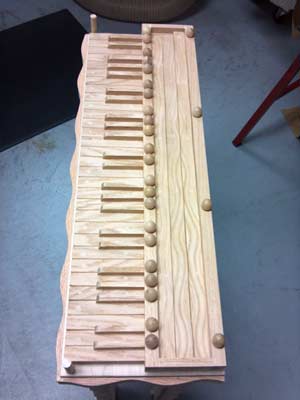
|
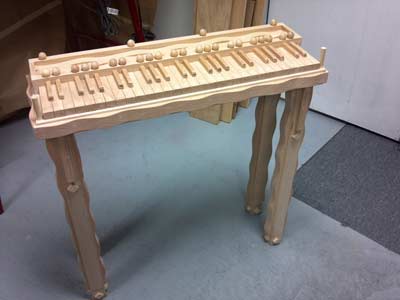
|
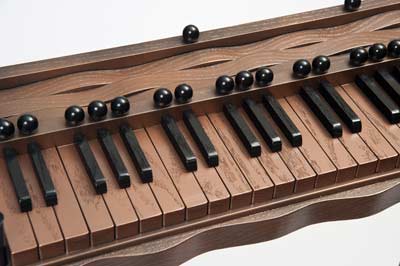
|
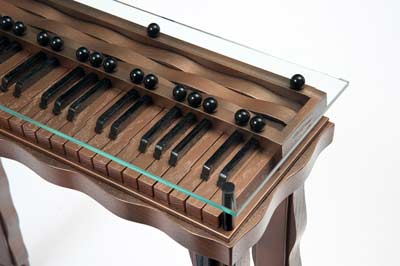
|
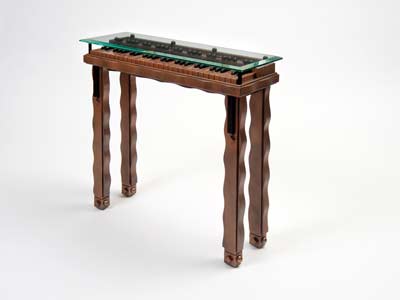
|
Another project that I applied my artistic interpretation to was the clock below. It started out as a 3-tiered base that I use for my birds, which I then designed up from there and turned it into the clock, which is 74" high.
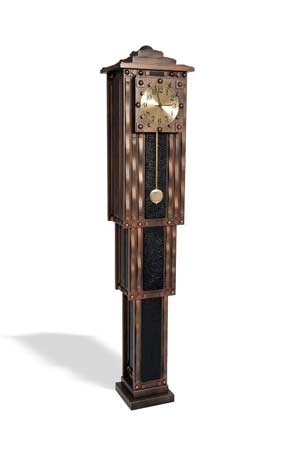
|
|
"Not Your Grandfather's Clock" is a timeless expression of function and art. Constructed from oak, oak veneer and maple. Finished with a metallic patina.
|
Materials
I have been using a lot of maple, oak, and oak veneer plywood. If I need a thicker piece, I'll use the good quality oak veneer plywood. I made a press where I can press the pieces together with glue, which allows me to make thicker pieces to use as a body. I also have 1-3/4" maple slabs made for me that are 24"x30" and are easy to carve. This material has been used to make the birds and the acoustic guitar.
I love using the oak for the grain that's in there. That will show through the finish that I put on there and it gives the piece a beautiful flow. With the oak I often create a wave effect, which allows you to see the grain of the oak in a cross section (not the regular grain you are seeing but rather a different angle that creates new grain patterns like circles and this wave effect). In the instruments this wave effect looks like sound waves, and it can also look like water in other projects.
The first piece that I did was part of my "pieces series." I was working down in my studio and my eye caught a bunch of 9x9 oak scrap pieces, and then an idea appeared in my mind. I dropped what I was doing, picked up the pieces, and decided to put these shapes in a matrix. I took the pieces and arranged them so each square was different. I loved the way it looked and showed them to my wife (her opinion is very important to me) and she loved them. I did a little experimenting and came up with 'Black Copper' finish. I have finished several pieces with color, and I have also brought in different carving textures, including a stone carving technique, which can make the oak and maple look like stone by carving it a certain way.
Below are several more of my pieces:
You can email Stephen at
info@stephenwiner.com
or check out his website at
www.theartofstephenwiner.com
.
Return to
Wood News
front page

